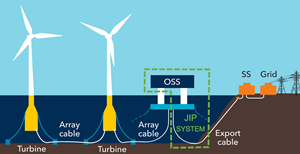 DNV has concluded Phase 1 of its joint industry project (JIP) aimed at establishing offshore substation standards for the growing floating wind sector. The collaborative industry effort has brought together 38 participating companies (including transmission operators, developers, component suppliers, Engineering, Procurement, Construction and Installation contractors, and yards) to tackle the distinctive challenges associated with floating offshore substations.
DNV has concluded Phase 1 of its joint industry project (JIP) aimed at establishing offshore substation standards for the growing floating wind sector. The collaborative industry effort has brought together 38 participating companies (including transmission operators, developers, component suppliers, Engineering, Procurement, Construction and Installation contractors, and yards) to tackle the distinctive challenges associated with floating offshore substations.Designing and implementing these substations present distinct challenges, including the need for high-voltage dynamic cables and electrical equipment that can withstand the movements of floating structures.The JIP's Phase 1 primary outcomes include affirming the feasibility of floating offshore substations (FOSS) and export cables, identifying technology gaps requiring attention, and highlighting the maturity of AC solutions compared to DC. The project also carried out a feasibility analysis for generic floater types and dynamic export cable concepts. Emphasizing a robust design process for optimized integrated floating substations, DNV plans to incorporate the JIP’s findings in the next update of DNV-ST-0145 for floating substations and of DNV-ST-0359 for dynamic cables, both scheduled for 2024. DNV is now initiating Phase 2 of this JIP, where Phase 1 participants and new participants will be invited to join. Phase 2 will build on Phase 1 deliverables and input received from the contributors.








